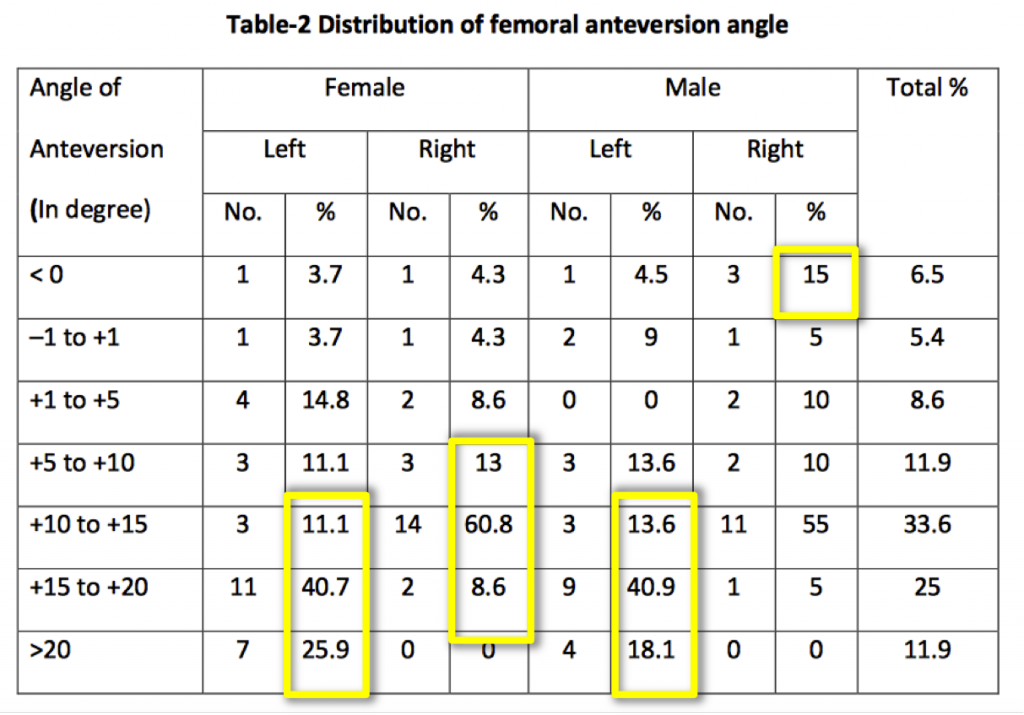Random Thoughts on Anatomy
A few weeks ago I taught a seminar on Total Hip Training (coincidentally, Tony Gentilcore and I are also teaching a full Total Hip and Shoulder workshop series in EDMONTON, ST. LOUIS, and CHICAGO. Click the cities for more info) and brought up the concepts of individual differences in joint structure, positioning, and even asymmetry between left and right.
To highlight this difference, you could look at the work by Zalawadia et al (2010) showing the variation in femoroacetabular anteversion, a measure of whether the acetabulum is considered to be in a neutral position, forward of neutral or back of neutral. A more anteverted position would be considered beneficial for hip flexion based movements, whereas a retroverted position would be more beneficial for extension based work. They showed a large range from 0 degrees or less of anteversion to greater than 20 degrees of anteversion, and even showed variation between left and right sides.
You can see there are significantly more males with their right hip at less than 0 degrees anteversion than both female hips combined, and women had both hips with a higher incidence of a greater anteversion angle than males.
This difference in left and right angles of anteversion could be a reason why we see people stand in postures like what the Postural Restoration Institute has pointed out as a potential issue, especially if left unchecked and allowed to be pushed enough to get pain or irritation.
The downside is this could be something that could potentially not be corrected due to the differences in left and right hips. Sometimes it just feels better to sit into one hip or the other, and it’s telling as to what you’re looking to do for more strength and more effective stability.
Because of these differences, it could be said that trying to set up for some exercises like deadlifts or squats could actually be causing you to stand in an imbalanced position based on your own anatomical differences, and could be causing you to work harder than you need to or lose power in your lifts.
Maybe focusing on symmetry could itself be producing muscle imbalances. – CLICK HERE TO TWEET THAT
Because of this when ever I’m teaching someone how to squat or deadlift I get them to play with their foot positioning, in width, individual rotation of the feet, and even whether one foot is forward of the other or not. In many instances, the individual will say they feel better, stronger, and more secure with somewhat of an asymmetric stance.
A good example of this was a powerlifter I was working with last week. This guy can pull close to 600 pounds, so it’s not like he’s a novice by any stretch of the imagination. When he set up for a conventional pull, his feet were pointed straight forward, and he wound up starting with some flexion through the lower lumbar region, around L3-S1. I had him pull his normal way, then adjusted his feet, first by turning his right foot out slightly (felt strong and powerful) then by turning his left foot out (felt “wonky” and weak), and then also seeing what his low back was doing with each. When his right toe was turned out, his low back flattened down almost to neutral. When his left toe turned out, there was no change in spinal position from his flexed straight forward presentation.
I had him pull a few more build up sets, working to 315, a very managable weight for someone who can max 600 on the platform, and he said he felt very strong and good, and like his glutes were working for the first time on deadlifts in years.
After this, he asked what the hell that was and how it could work so immediately, with a posture that resembled a dog immediately after being asked if he wants to go for a car ride.
I talked about the differences between left and right and how everyone is a little different. I couldn’t tell what stance would work for him, he had to feel it and see what worked for him, but once we got there he noticed it was a huge difference.
Does this relate to stuff like “leg length discrepancies,” those diagnoses where someone is assumed to have a difference in leg lengths that is causing their problems? Well, if we as a species has been expected to evolve through the millenia and we can’t tolerate a small difference between the lengths of our legs, we’re showcasing how poor we are at adapting to our environment.
I had a Skype consult with a guy who was diagnosed with a leg length discrepancy, which essentially was coming from a pelvic rotation where one side was posterior and the other was anterior, causing the appearance of one leg being shorter than the other.
We spent a few weeks doing some asymmetrical hip and core work to reduce the rotation between the hips and get him to find some different postures, and he went back to the person who initially diagnosed them. They now said the leg length discrepancy was gone!! Amazingly, we managed to lengthen his bone without the use of cumbersome surgical techniques! There’s hope for the world yet.
I rarely ever believe a leg length discrepancy as it’s commonly considered actually exists, unless the person has a history of a fractured leg when they were a child. If no such injury has ever occurred, there’s the possibility they would have a congenital defect where they developed with one leg shorter than the other. In most cases, this difference can come down to alignment, either from the foot or from the pelvis, so working on those areas seems to work really well.
Because of these anatomical differences, and because of the fact that we will all have a “best” position to be in for developing stability and power, which is rarely in a symmetrical stance, we each have to take time to figure out what stance works best for us, what grip works best, and where we should look to put our efforts in lifting. Asymmetry, while it may seem counterintuitive at first, makes perfect sense when viewed in this light.
Hopefully these random ramblings make sense. Let me know what you think.




10 Responses to Random Thoughts on Anatomy